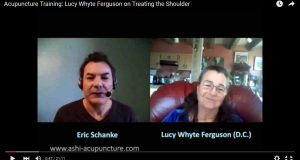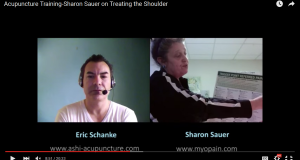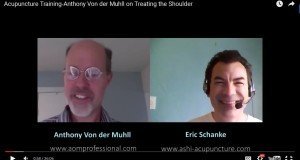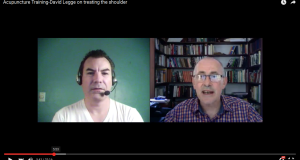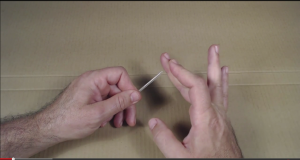#1 Doorbell I practice in a small town and the majority of patients I see have never had acupuncture before. But even within this small minority of patients who have had acupuncture before, I have heard many, many times how they were left trapped and uncomfortable by another acupuncturist. It is the number one complaint I’ve heard about other acupuncturists. ...
Read More »Acupuncture Training
Acupuncture Training: Lucy Whyte Ferguson on Treating the Shoulder
Author and trigger point expert Lucy Whyte Ferguson D.C. shares her insights into treating frozen shoulder. About the Guest Dr. Ferguson has studied and collaborated with many of the icons of trigger point therapy. She refers to herself as the “Forest Gump” of chiropractic because of her luck in being in the right place at the right time. She was ...
Read More »Acupuncture Training – Sharon Sauer on Treating the Shoulder
Trigger point expert Sharon Sauer shares decades of experience on treating the most common type of shoulder pain she sees; pain in the front of the shoulder. She explains how this is commonly caused by trigger points in the infraspinatus muscle, introduces some range of motion tests to help determine if the infraspinatus is the cause, and which part of ...
Read More »Acupuncture Training: Anthony Von der Muhll on Treating the Shoulder
In this interview, Anthony shares his great insights on the word Qi and on treating the shoulder. He emphasizes how Qi is a context specific term within a very context specific language. And has fantastic advice on how to treat shoulder problems. About the Guest Anthony Von der Muhll L.Ac., DNBAO, FAAPM has served as a Clinical Instructor in the ...
Read More »Acupuncture Training – David Legge on Treating the Shoulder
I interview David Legge, getting his thoughts on the concept of Qi and his valuable insights on treating the shoulder. About the Guest David Legge is an author and senior practitioner of acupuncture. He has made valuable contributions to the field with his books on treating musculoskeletal pain and on elucidating the concept of the Jingjin. Books by the Guest ...
Read More »Acupuncture Haemothorax
Another article documenting an adverse effect of acupuncture has come out. This article describes a haemothorax that occured from acupuncture. So what’s the difference between a haemothorax and a pneumothorax? A haemothorax is a collection of blood in the plueral space vs a collection of air in the pleural space. The article mentions electro-acupuncture being used and also “intense ...
Read More »Acupuncture for Satellite Trigger Points
Recently a colleague and I were discussing a problem that happens sometimes when doing trigger point work. You treat an area that is tight and tender, but the patient doesn’t improve. Or they will improve only temporarily. This is a broad topic but I want to address one aspect of this problem and try to address other aspects of it ...
Read More »Keep in Touch!
Over the years I have received thanks from many patients for this one simple action. They thank me for touching their forearm during the treatment. Some have expressed that they wished their “regular” doctor would touch them like that because it was so reassuring. I’ve had the same experience. Last time I went to the dentist, I thought it would ...
Read More »Get a Mentor!
Mentorship is valuable in every field. I encourage everyone that is studying acupuncture to find a mentor. I’ve had 2 main mentors since I started studying acupuncture. The first mentor I had was Jing Chen author and illustrator of An Anatomical Atlas of Chinese Acupuncture Points. While I was going to school, I spent 2 years working for him. I ...
Read More »Acupuncture Insertion Training Tool!
This video will guide you step by step to make a handy dandy spring loaded acupuncture needle insertion training tool! If you watch the video on the Ashi Acupuncture Youtube channel, you’ll be able to navigate the video using the time annotations in the description.
Read More » Ashi Acupuncture – Education and Training Acupuncture and dry needling information, training and education. Medical based acupuncture with an emphasis on anatomy and technique.
Ashi Acupuncture – Education and Training Acupuncture and dry needling information, training and education. Medical based acupuncture with an emphasis on anatomy and technique.


